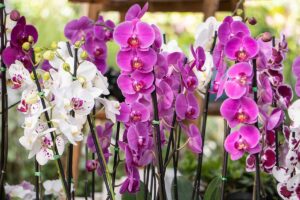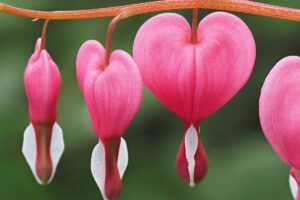Oenothera macrocarpa
As a born and raised Missourian, any plant with my home state in the name immediately earns my endearment.
But even for folks raised outside of the Show Me State, the Missouri evening primrose is quite worthy of affection.
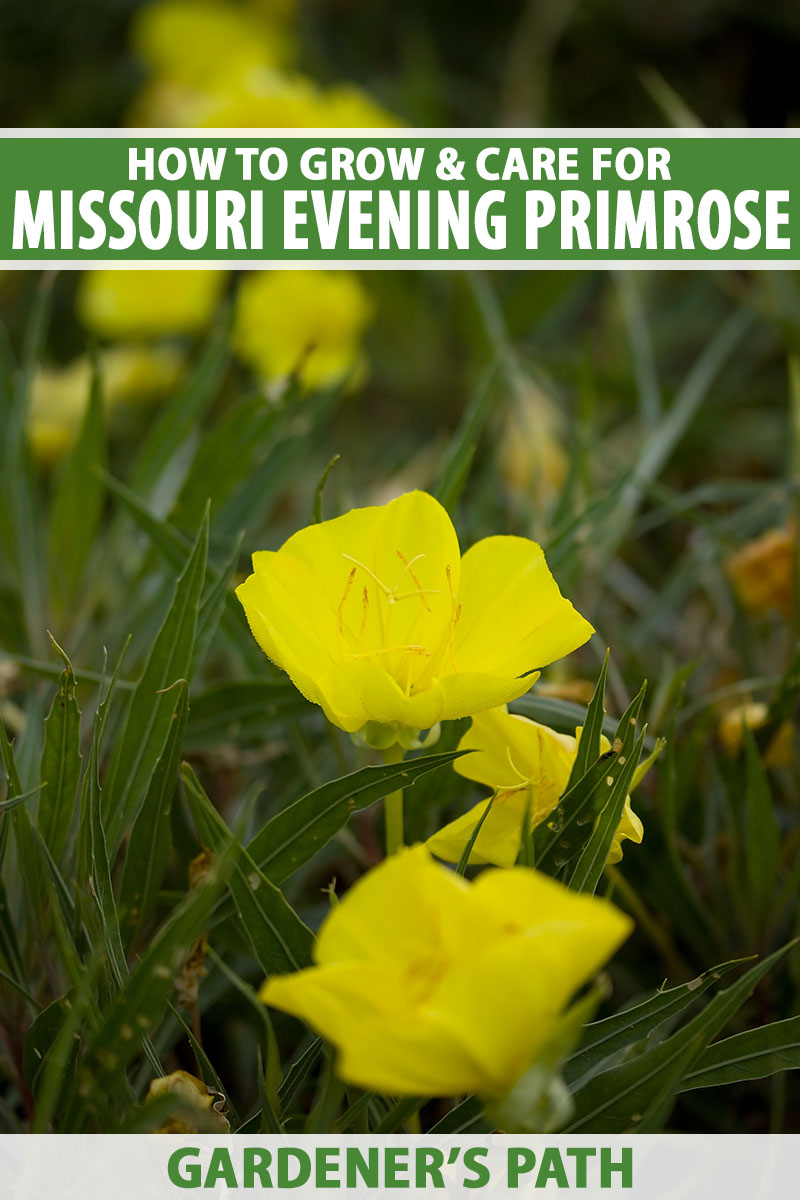
We link to vendors to help you find relevant products. If you buy from one of our links, we may earn a commission.
And just like Missouri, this herbaceous flowering perennial is absolutely gorgeous.
Its striking yellow blooms are unique among flowers: they open late in the day before closing up for good the following morning. Basically, it’s the botanical equivalent of a movie showing on opening night!
But don’t think for a second that this dazzle comes with delicacy. Tolerant of drought and shoddy soils, Oenothera macrocarpa can thrive where other flowers fear to put down roots.
Such toughness comes with low maintenance requirements, as well – no need to coddle the plant and tend to its every need like you would with a more dainty flower.
That being said, the Missouri evening primrose will look its best if you care for it properly. And in this guide, we’ll go over how to do just that.
Need specifics? Take a gander:
What You’ll Learn
What Is the Missouri Evening Primrose?
Hardy in USDA Zones 3 to 7, the Missouri evening primrose is a herbaceous flowering perennial of the Onagraceae, or the evening primrose family.
Native to the southern and central United States, the plant is often found growing naturally in dry forest clearings, along roadsides, in limey soils, and on well-lit and well-draining rocky bluffs.
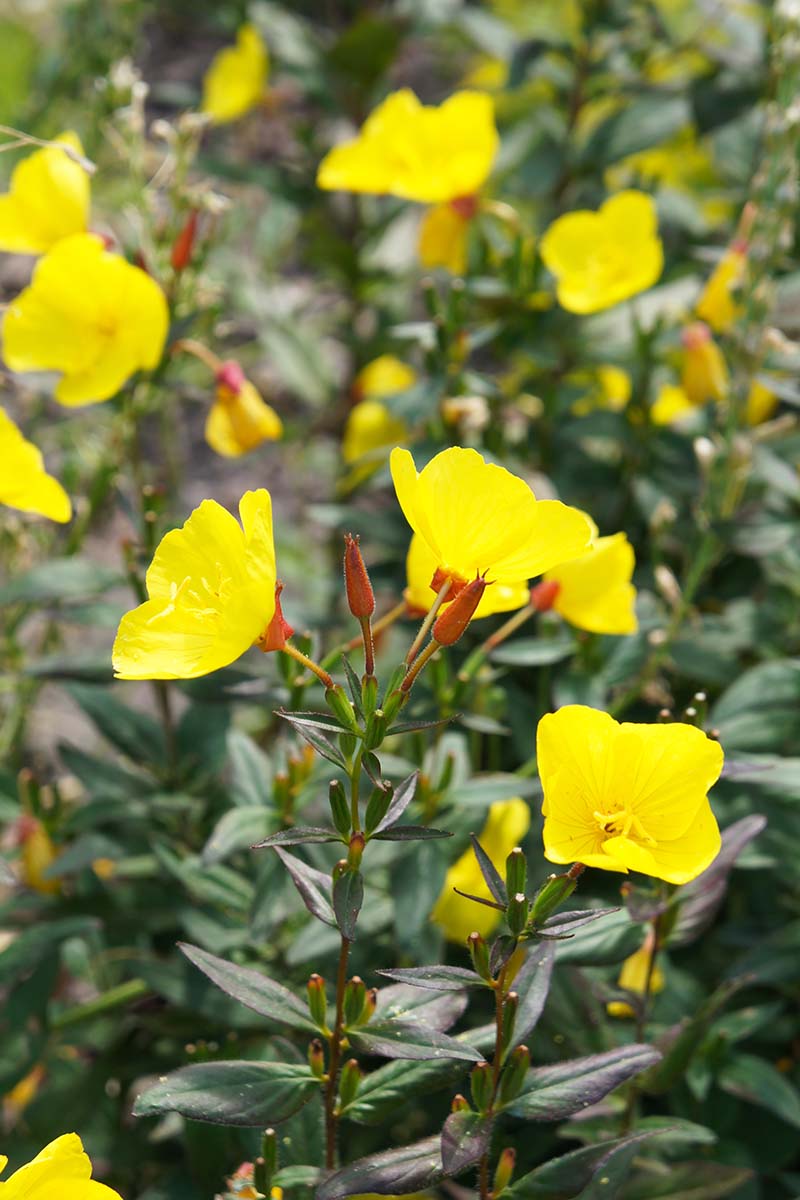
Within the Onagraceae family, the Missouri evening primrose belongs to the Oenothera genus, comprising 140 or so species of sundrops and evening primroses.
While they look similar, they flower differently. In general, sundrops bloom during the day, while evening primrose flowers open later on, usually at dusk.
There are actually five subspecies of Missouri evening primrose, which have slightly different distributions within the southern and central United States: fremontii, incana, macrocarpa, mexicana, and oklahomensis.
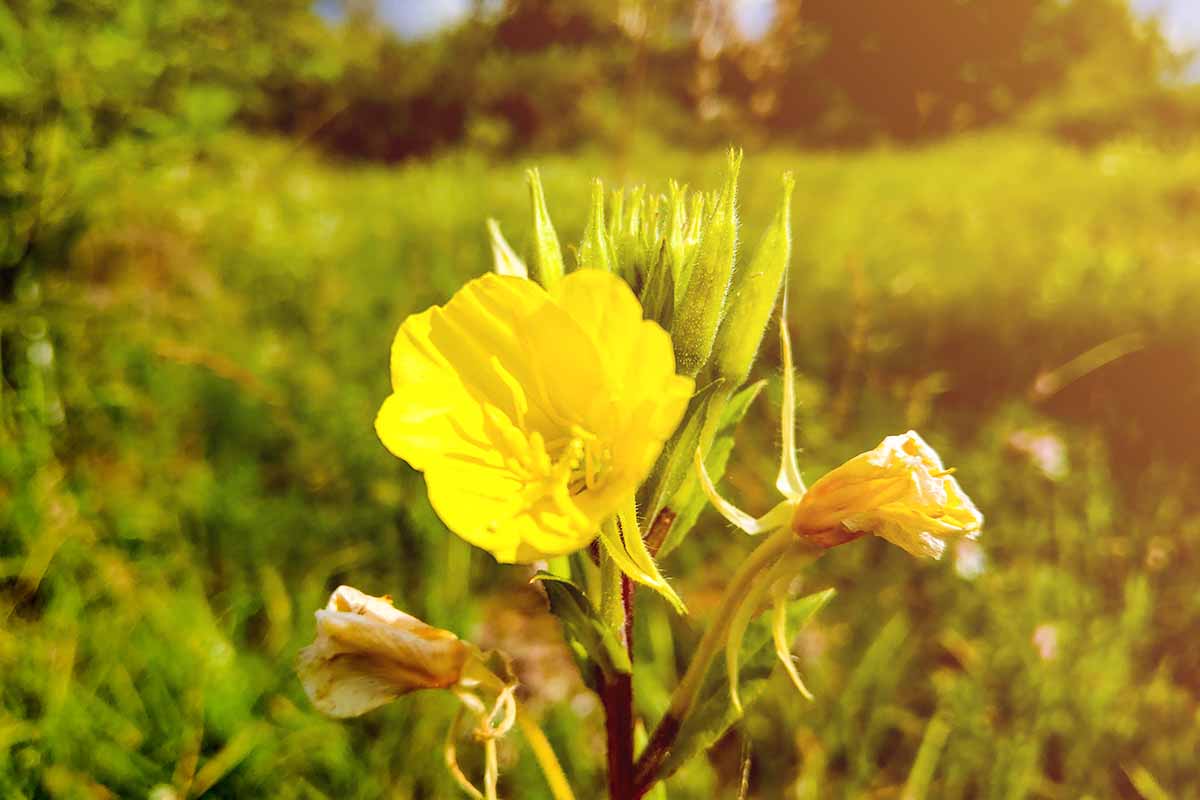
Reaching a mature size of approximately nine to 12 inches tall and 12 to 18 inches wide, O. macrocarpa has a low and sprawling habit.
The plant flaunts two- to four-inch, lance-shaped green leaves alongside yellow, fragrant, and floppy flowers, which are about three to four inches wide.
Beginning in summer, the show-stopping flowers open in the evening, leaving them ready for pollination from night-flying insects such as sphinx moths.
The following morning, the flowers close up and expire. But don’t worry – new flowers will take their place throughout a beautiful blooming period of at least two whole months!

If fertilization occurs, large green fruit capsules will later form – hence the species name macrocarpa, meaning “large-fruited” – with a four-winged shape that reminds me of a dart’s tail fins.
The fruit eventually ripens to a papery brown texture, opening its tip to disperse brown to tan, oblong seeds with points at either end. If you’re a fan of breaded poultry, they may remind you of fried chicken wings.
The Missouri evening primrose primarily spreads via self-seeding, although it thankfully doesn’t spread as aggressively as its relative O. speciosa.
With a strong, fleshy taproot system, an individual specimen can persist in your garden for several years, if you so desire!
Cultivation and History
As a whole, plants in the Oenothera genus have a history of use across many domains, from food to medicine to even genetic research!
But the Missouri evening primrose in particular is a pretty humble bit of flora, relatively free from the historical fame and/or infamy of plants such as indigo and bamboo.

It did, however, manage to catch the attention of the UK’s Royal Horticultural Society, whose members gave the plant their coveted Award of Garden Merit back in 1993!
And it goes without saying that the plant is beloved by present-day gardeners for its toughness, beauty, and unique flowering time.
Missouri Evening Primrose Propagation
Craving some Missouri evening primrose? I don’t blame you – they are aesthetically scrumptious.
The best ways to get your fix are by sowing seeds or transplanting.
From Seed
To obtain seeds, you can purchase some, acquire them from a friend, or harvest seed-bearing fruits from mature plants in late summer to fall.
To harvest the seeds during this time, wait to pluck the fruit until after they turn brown and papery, but before the fruit tips open up – this will require regular monitoring.
Time it just right, and you’ll have fruit capsules of ready-to-sow seeds. Wait too long, though, and the seeds will spill out on the ground.
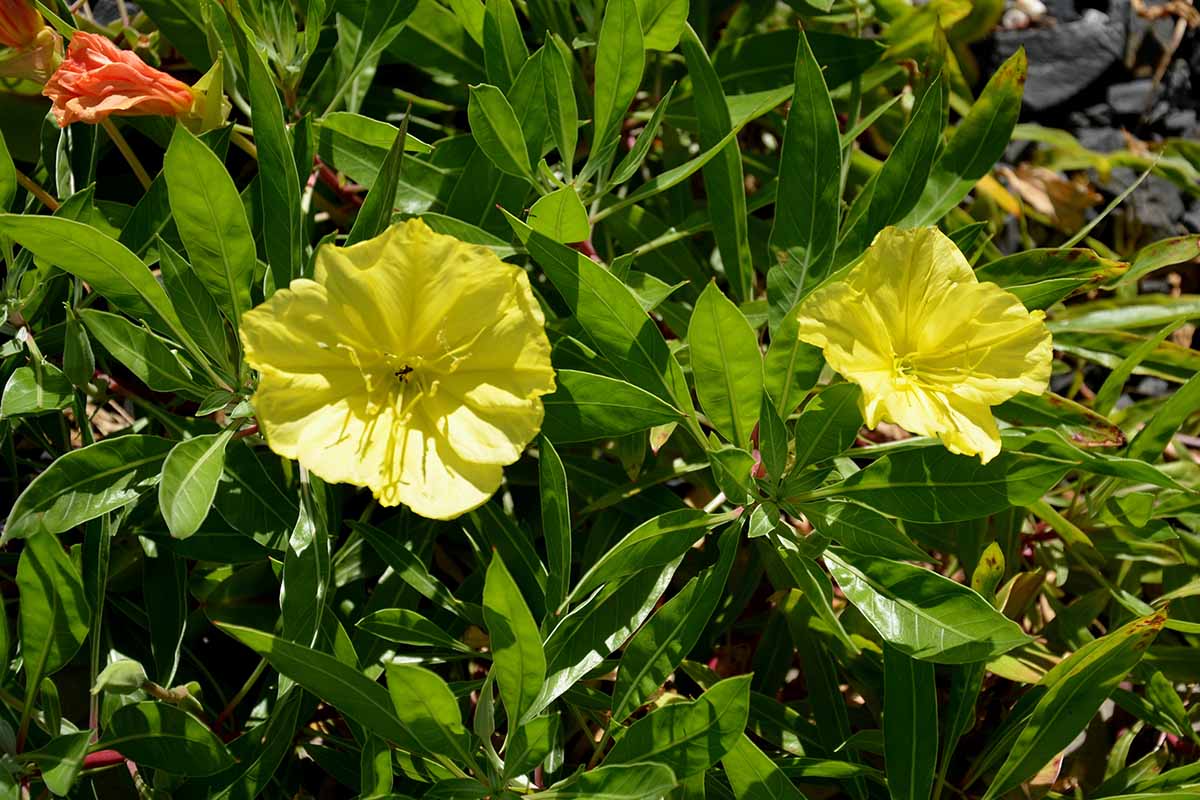
Have your unopened fruit capsules? With a sharp and sterile blade, make a puncture hole at the tip of the fruit and work it open, either with the blade or your fingers. Gently shake out the seeds within, and presto!
Alternatively, you could tie gauzy organza bags over the fruits to catch the seeds as they fall naturally, while also allowing for light and airflow. It’ll definitely take the guesswork out of harvesting!
From here, you can either sow the seeds directly outdoors in fall, or cold-stratify them indoors prior to sowing them outdoors the following spring.
For fall sowing, sow the seeds in groups of four just below the soil line in well-draining garden soil of about average fertility, with a pH of 6.0 to 7.0.
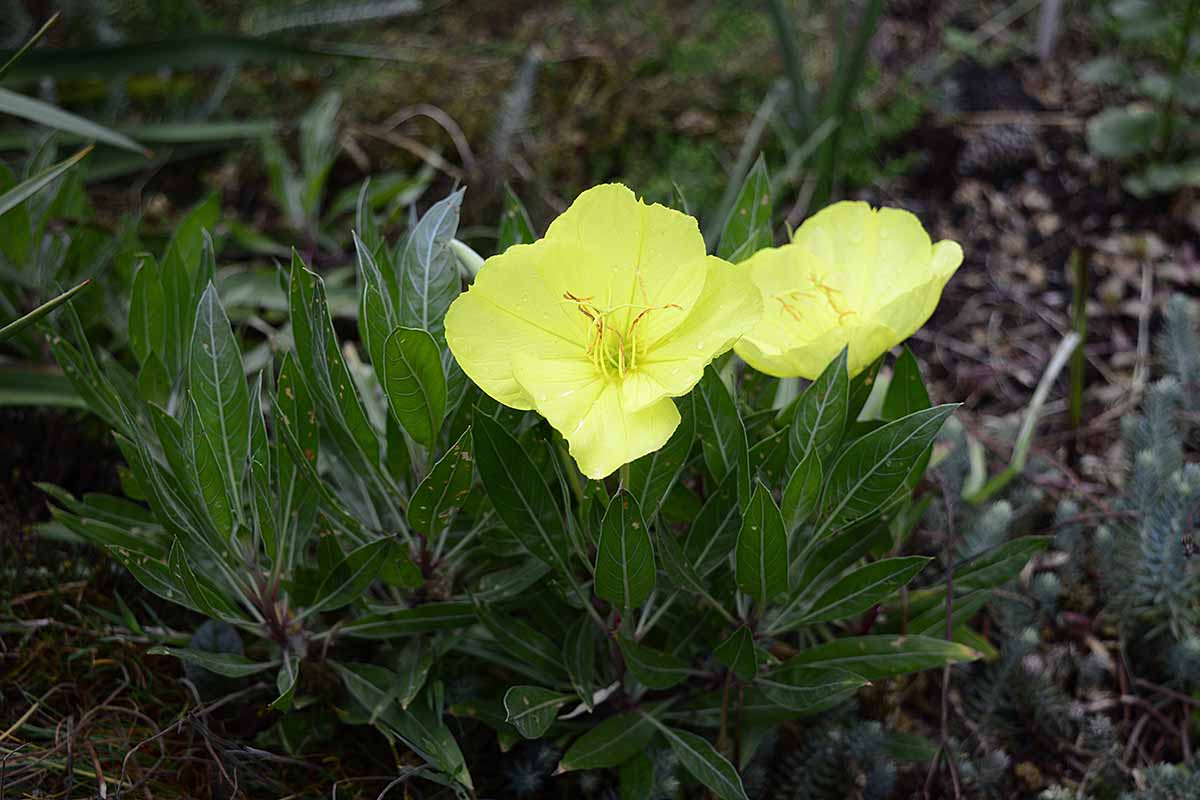
Space the seeds about 18 to 24 inches apart, and ensure that the sites aren’t adjacent to tall perennials, as Missouri evening primrose doesn’t compete well with them.
Keep the soil moisture up until temperatures dip below freezing, at which point you’ll let nature do its thing until the final frost in spring.
For spring sowing, hold onto the seeds until at least two months before the intended post-frost planting date. At this point, stick the seeds in a plastic baggie of moist sand and place it in the refrigerator.
Continue to keep the sand moist throughout its stay in the fridge. After 60 days of cold stratification, the seeds will be ready to sow outdoors with the above-described fall-sowing protocol.
Come the warmth of spring, the seeds should germinate within a couple of weeks. In each group of four, thin the seedlings down to their strongest member as they become apparent.
Throughout their first growing season or two, keep the soil moist but avoid oversaturating it. Reduce watering as described below once established.
Via Transplanting
Not all about seed sowing? Well, thank goodness for transplants.
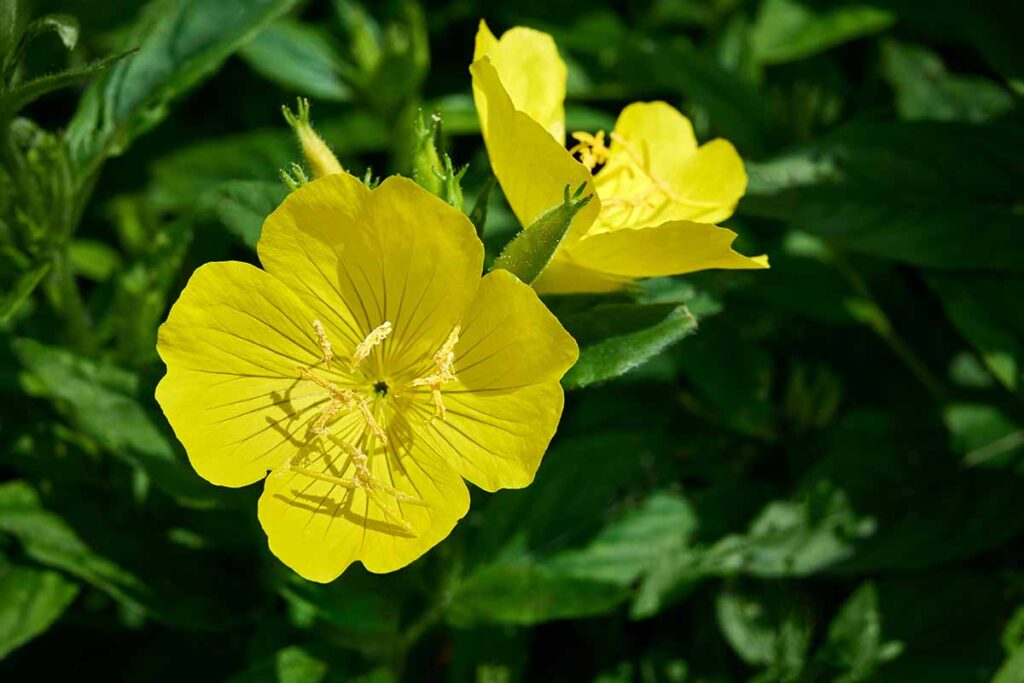
After you prepare your planting sites, dig holes deep enough to accommodate the transplants’ taproot systems, and make them just a bit wider.
Gingerly lower each transplant into its hole, backfill with adjacent soil, and water in.
Until the transplants establish themselves after their first year or two, add water as needed to maintain soil moisture, but without saturating the soil.
How to Grow Missouri Evening Primrose Plants
The Missouri evening primrose doesn’t need much in the way of help, but the right cultivation methods can take the plant’s health and aesthetics from good to great.
Climate and Exposure Needs
In order to survive outdoors year-round, O. macrocarpa needs to be grown in USDA Hardiness Zones 3 to 7.
And while it does require full sun for optimal growth, some light shade is tolerable.
Soil Needs
Just like with a colander, proper drainage is absolutely essential. For Missouri evening primrose, root rot can easily occur in soils that don’t drain well, especially in winter.

But don’t worry too much about fertility, as O. macrocarpa can tolerate lean soils.
When it comes to soil pH, a standard recommendation of 6.0 to 7.0, or slightly acidic to neutral, is appropriate. If the soil is a bit basic, though, don’t fret – moderate soil alkalinity is also tolerable.
Irrigation and Fertilizer Needs
The toughest characteristic of O. macrocarpa is definitely its drought tolerance.
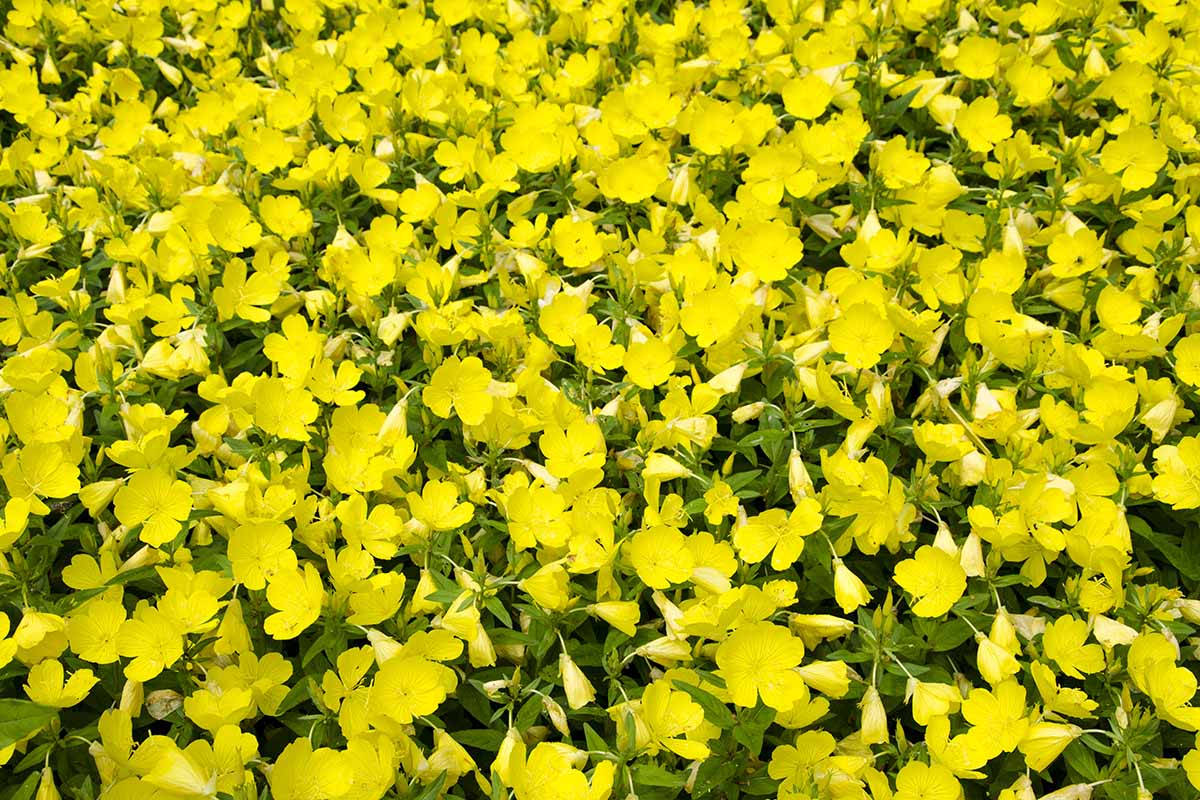
Depending on the average rainfall and temperature in its local climate, a Missouri evening primrose may do just fine without supplemental irrigation.
But in general, you’re best off watering these guys whenever the soil dries out.
Fertility-wise, there’s no need for supplementation. Amending the soil with an inch or so of organic matter can make the soil more friable and workable, though.
Growing Tips
- Full sun is optimal, while light shade is tolerable.
- Be sure to provide ample drainage.
- Water whenever the soil dries out.
Pruning and Maintenance
To enjoy as many flowers as possible throughout the blooming period, you should pluck spent blooms as they become apparent on the plant. Learn more about deadheading in our guide.
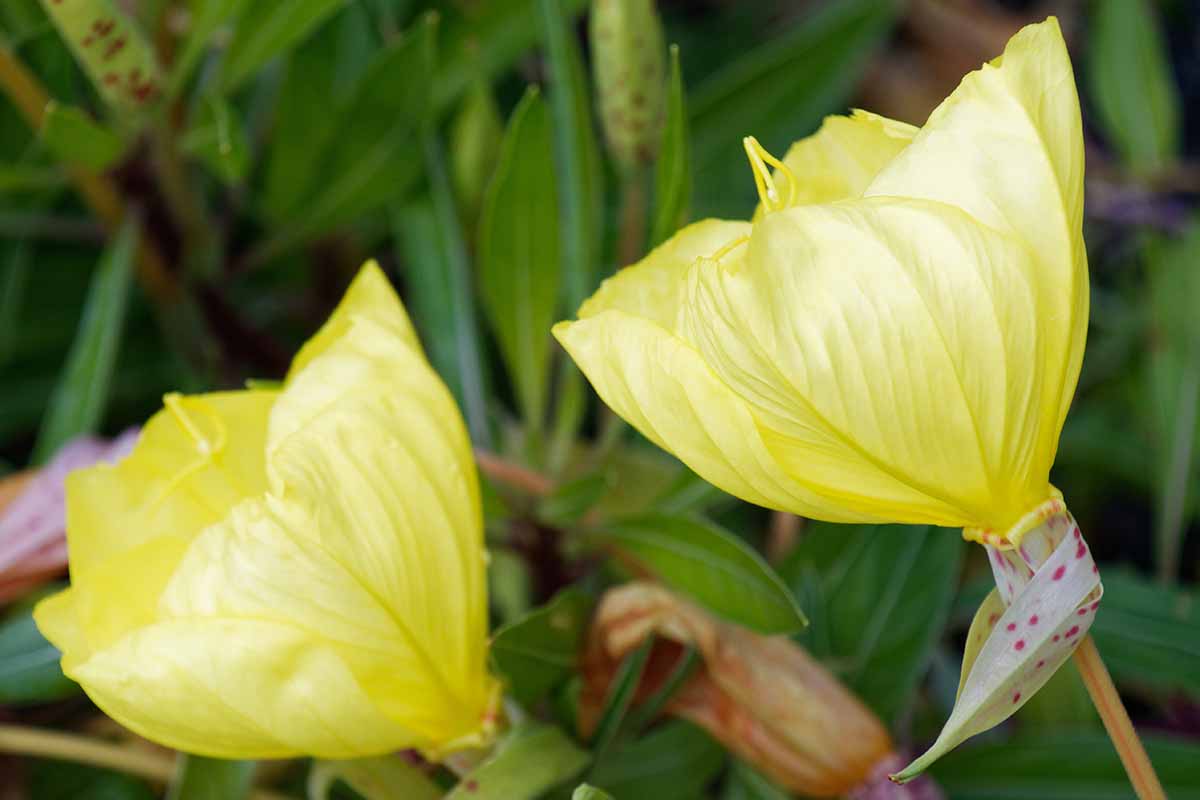
Since this plant does spread by self-seeding, it may behoove you to pull any unwanted seedlings as they emerge, lest you have more Missouri evening primrose on your hands than you’d like.
Missouri Evening Primrose Cultivars to Select
There’s actually more cultivars of O. macrocarpa available than you’d think. Let’s go over a few!
Greencourt Lemon
Hardy in USDA Zones 3 to 8, ‘Greencourt Lemon’ is notably different from the standard species.
Its flowers are a lighter yellow, its leaves are more wavy and colored a gray-green, and it produces intermittent blooms until fall.
A solid choice for when you want to ornamentally shake things up a bit!
Lemon Silver
Continuing with the lemony theme, ‘Lemon Silver’ is a compact, silver-leaved version of O. macrocarpa ssp. fremontii.
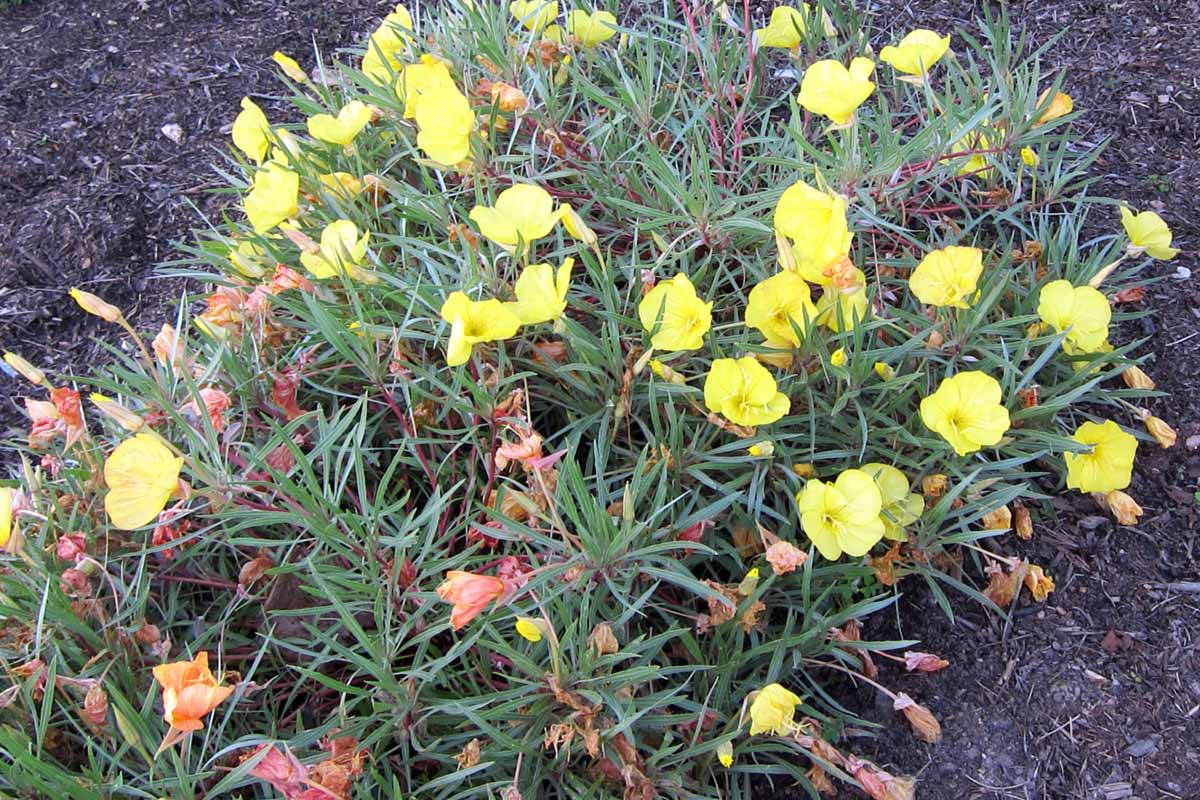
With a slightly reduced height of about six to eight inches, ‘Lemon Silver’ is perfect for keeping all that silvery splendor close to the ground.
Shimmer
Another variety of the fremontii subspecies, ‘Shimmer’ flaunts pale yellow petals alongside skinny silver foliage.
As a result of being modestly slender, the leaves offer up even more of the ornamental spotlight to the blooms, proving that sometimes, less is more.
Managing Pests and Disease
As if its resistance to drought and shoddy soils wasn’t enough, a Missouri evening primrose is deer- and rabbit-resistant! Plus, it isn’t typically one to suffer from significant pest or disease issues.
However, overwatering and/or inadequate drainage can lead to root rot, a condition where the roots become necrotic thanks to a lack of oxygen.
Understandably, this condition can lead to significant floral and foliar decline above the soil line.
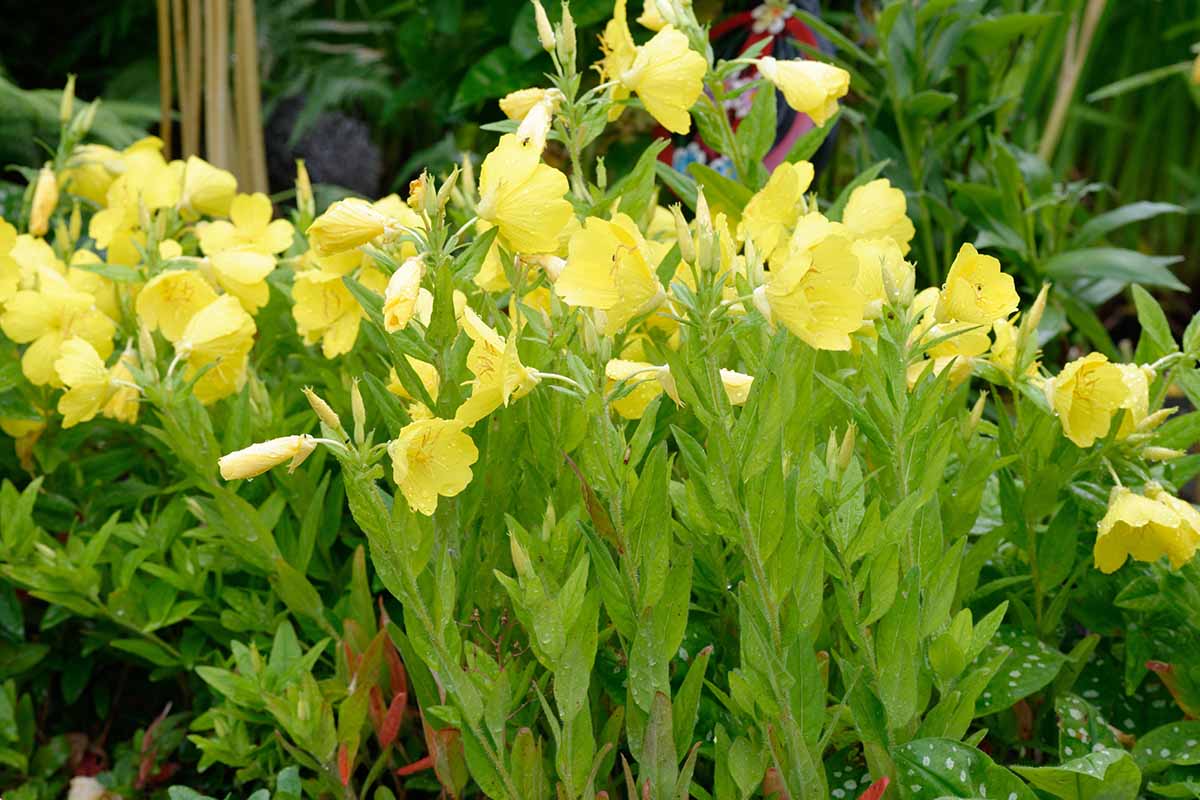
Root rot can be prevented with a one-two punch of well-draining soil and moderate irrigation.
If a plant ends up afflicted, improving drainage, reducing your watering, and/or pruning away the necrotic sections of the roots could give the specimen a fighting chance.
If that fails to work, then the plant should be lifted and pitched.
Best Uses for Missouri Evening Primrose Flowers
O. macrocarpa ain’t a one-trick pony, folks.
It can provide a delightful edge at the front of borders and alongside walkways, it looks right at home in a rock, native, or cottage garden, and the sprawling form makes it a splendid selection for raised beds.
Heck, you can even clip the stems to use the seed capsules in flower arrangements.
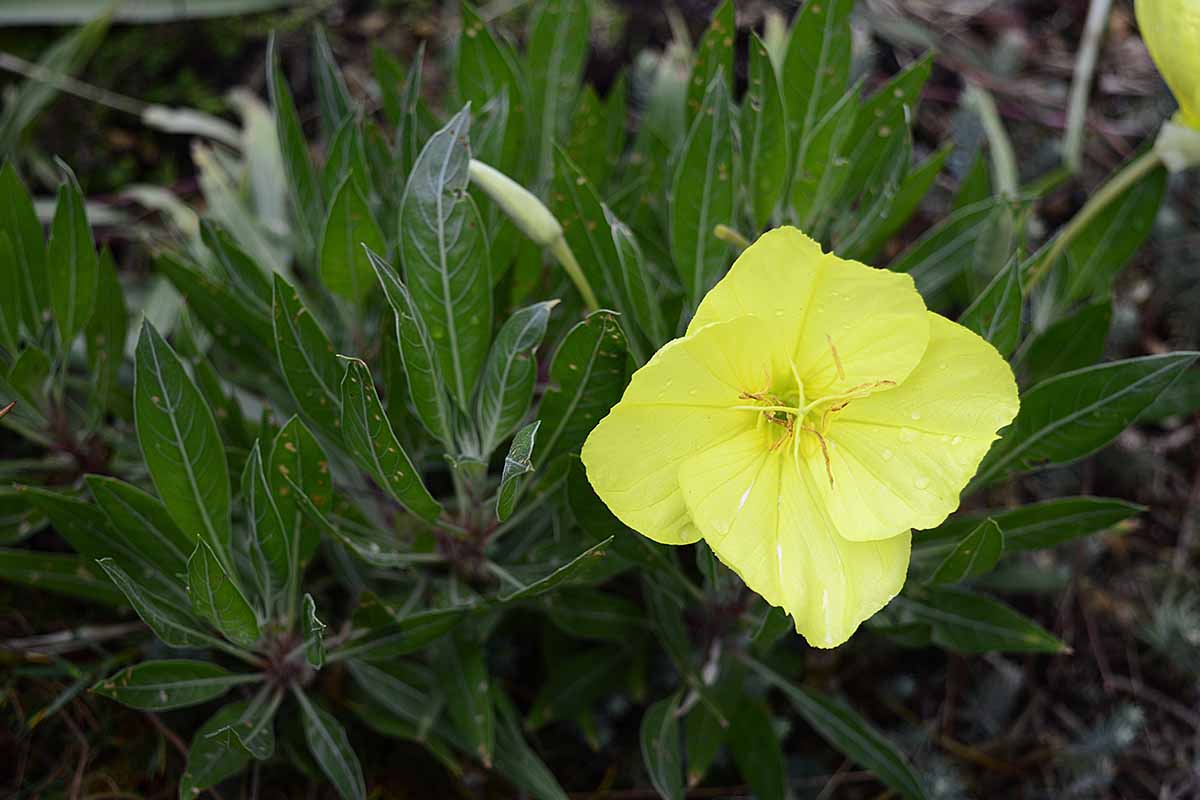
But much like five-foot-five folks have a tough time guarding seven-foot-three NBA players in a game of basketball, Missouri evening primroses don’t compete well with taller perennials.
Therefore, it would behoove you to place these guys near plants of a similar or shorter height.
Quick Reference Growing Guide
| Plant Type: | Herbaceous flowering perennial | Flower/Foliage Color: | Yellow/green |
| Native to: | Southern and central United States | Maintenance: | Low |
| Hardiness (USDA Zones): | 3-7 | Tolerance: | Alkaline soil, deer, drought, light shade, poor soils, rabbits, various soil types |
| Bloom Time: | May-August | Soil Type: | Average to lean |
| Exposure: | Full sun | Soil pH: | 6.0-7.0 |
| Spacing: | 12-18 inches | Soil Drainage: | Well-draining |
| Planting Depth: | Slightly below soil surface (seeds), depth of root system (transplants) | Attracts: | Butterflies, hummingbirds, moths |
| Height: | 9-12 inches | Uses: | Border fronts, cottage gardens, cut flowers, dried arrangements, native gardens, pathways, raised beds, rock gardens |
| Spread: | 12-18 inches | Order: | Myrtales |
| Growth Rate: | Moderate | Family: | Onagraceae |
| Water Needs: | Low | Genus: | Oenothera |
| Common Diseases: | Root rot | Species: | Macrocarpa |
A Good Evening Indeed
As you take a late-day walk in your summertime landscape and note the gorgeous flowers of the Missouri evening primrose, you’ll have a hard time denying how awesome evenings can be.

Add the low care requirements of these plants, and you’ll be on Easy Street. Add the typical lack of health issues on top of that, and you’ll be on Even Easier Street. It’s the good life, I say.
Questions, remarks, praise for Missouri? Put ’em all in the comments below.
Trying to grow other wildflowers? These guides will provide marvelous starting points:
